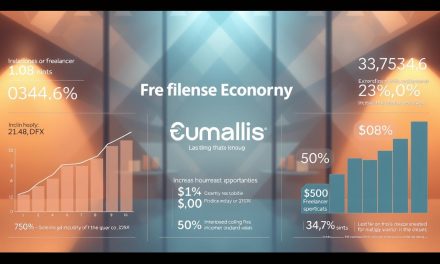What if you could achieve career stability without sacrificing the freedom of being your own boss? For many professionals, this dream becomes reality through strategic self-employment arrangements that blend autonomy with security.
Self-employed professionals operate through service agreements rather than traditional employment structures. These project-based collaborations allow businesses to access specialized skills while giving workers control over their schedules and client relationships. The arrangement’s popularity stems from its mutual benefits – companies reduce administrative costs, while professionals gain diverse income streams.
This model powers today’s gig economy, enabling everything from short-term tech projects to ongoing creative partnerships. Unlike conventional jobs, these roles focus on delivering specific results rather than fulfilling hourly obligations. Clear contracts define expectations, creating professional boundaries that protect both parties.
Understanding these dynamics helps workers build sustainable careers. Proper agreements ensure fair compensation while maintaining the flexibility that makes self-employment appealing. With the right approach, professionals can transform temporary projects into long-term client relationships.
Table of Contents
Key Takeaways
- Self-employed professionals operate through negotiated contracts rather than traditional employment terms
- Project-focused collaborations benefit businesses needing specialized skills without long-term commitments
- Clear service agreements protect both workers and clients while defining project scope
- The gig economy thrives on these flexible, results-driven working relationships
- Proper contract management helps convert short-term projects into recurring opportunities
- Strategic self-employment combines autonomy with financial security through diversified income
Understanding the Independent Contractor Role
Professionals across industries are redefining success through flexible work models. Unlike traditional employees, these specialists operate under agreements that prioritize results over rigid schedules. Their status hinges on specific legal distinctions that shape everything from project control to financial responsibilities.
Defining the Self-Employed Specialist
Contractors function as external partners rather than staff members. Doctors, designers, and construction professionals often choose this path to maintain control over their workflows. A key differentiator lies in decision-making autonomy – they determine how services get delivered, unlike employees who follow employer directives.
This arrangement spans sectors from healthcare to tech. Fitness instructors might design personalized training programs, while writers craft content for multiple brands simultaneously. What unites them? Specialized expertise that clients actively seek out.
Balancing Freedom and Responsibility
The contractor model offers notable benefits. You set your rates, choose projects aligning with your skills, and manage tax deductions for business expenses. Many professionals leverage these perks to earn more than traditional salaries while avoiding office politics.
However, this path demands careful planning. Unlike employees, contractors handle their own insurance, retirement savings, and tax obligations. Successful specialists often diversify income streams and maintain emergency funds to offset irregular cash flow.
Real estate agents and photographers exemplify this balance. They build client portfolios while managing administrative tasks typically handled by employers. The key lies in recognizing both the opportunities and commitments this status entails.
Expert Advice for independent contractors

Building a thriving career in today’s dynamic markets requires smart planning and specialized approaches. Self-employed professionals can unlock exceptional opportunities by combining strategic thinking with operational flexibility.
Mastering Flexible Work Structures
Successful specialists design their schedules around both personal needs and project demands. Caregivers might cluster client meetings during school hours, while night owls reserve creative tasks for peak productivity times. This intentional structuring preserves work-life balance without compromising service quality.
Seasoned professionals recommend setting clear boundaries through project selection criteria. Focus on assignments that align with your expertise and long-term goals. One marketing consultant shares: « Choosing clients who value my niche knowledge doubled my rates in 18 months ».
Optimizing Earnings Through Market Awareness
Market fluctuations create prime opportunities for premium pricing. Track industry trends to identify peak demand periods for your services. Web developers often increase rates during e-commerce holiday preparation phases, while tax specialists capitalize on fiscal year-end deadlines.
Develop systems to manage multiple projects efficiently. Use productivity tools to track deadlines and maintain consistent communication across clients. Many successful workers establish essential contractor agreements that protect both parties while ensuring fair compensation.
Position your business as a solution provider rather than a commodity service. Highlight specialized certifications or unique methodologies in proposals. This approach helps companies recognize the strategic value you bring beyond basic task completion.
Tax Obligations and Financial Considerations
Managing finances requires careful planning when you’re self-employed. Unlike traditional employees, professionals in this category handle unique tax responsibilities that impact both short-term cash flow and long-term security.
Self-Employment Tax and Quarterly Reporting
Self-employment tax covers your full Social Security and Medicare contributions – costs typically split between employers and staff. This means setting aside 15.3% of net earnings for these obligations. « Quarterly payments prevent year-end surprises, » notes a Paris-based financial advisor. Use Form 1040-ES to calculate and submit estimated taxes every three months.
Clients paying over $600 annually must issue Form 1099-MISC. Cross-reference these with your records to ensure accurate income reporting on Schedule C. Discrepancies could trigger audits or penalties.
Business Deductions and Estimated Taxes
Strategic deductions lower taxable income significantly. Qualified expenses include:
- Home office costs (utilities, rent proportional to workspace)
- Professional tools like specialized software
- Business-related travel and education
Track expenses using cloud accounting tools for real-time visibility. Many professionals allocate 25-30% of income for tax obligations. Our guide to essential tax strategies helps you manage these requirements while maximizing deductions.
Remember: Proper documentation proves crucial during audits. Maintain organized records of receipts, invoices, and mileage logs throughout the fiscal year.
Legal Protections and Proper Contractor Agreements

Clear legal frameworks form the backbone of secure project collaborations. Well-structured agreements protect both service providers and clients while ensuring compliance with labor regulations.
Essential Elements of a Contractor Agreement
Effective contracts specify deliverables rather than work processes. Key components include:
- Detailed scope of services with measurable outcomes
- Payment terms tied to milestones or completed work
- Intellectual property ownership clauses
- Termination conditions for both parties
These elements demonstrate the business-to-business nature of the relationship. A properly drafted contractor agreement clarifies autonomy over work methods, reinforcing your status as a specialist rather than an employee.
Risks of Misclassification
Incorrectly labeling workers can trigger audits and penalties. Authorities examine control over work schedules, tools used, and financial arrangements to determine employment status. One legal expert notes: « Misclassification cases often hinge on whether the worker operates independently or under direct supervision. »
Consequences include:
- Back taxes plus interest charges
- Fines up to 5% of annual revenue in France
- Damage to professional credibility
Regularly review contracts with legal counsel to maintain compliance. This proactive approach safeguards your career while building trust with clients.
Differentiating Between Employees and Contractors
Clear distinctions separate traditional employment from project-based collaborations. Understanding these differences protects both workers and businesses while ensuring legal compliance. Let’s explore the critical factors that define each relationship.
Control Over Work and Decision Making
True independence hinges on autonomy in work execution. Employees typically follow set schedules and methods dictated by employers. In contrast, self-employed professionals determine their processes, tools, and timelines.
A legal expert clarifies: « The right to control only the final result – not daily operations – defines contractor relationships. » Clients specifying work hours or mandatory meetings risk blurring this boundary. Protect your status by maintaining authority over how deliverables get created.
Comparing Financial Risks and Benefits
Financial responsibility varies significantly between these roles. Employees receive expense reimbursements and face no liability for unmet targets. Contractors absorb operational costs but gain potential for higher profits through strategic pricing.
| Factor | Employee | Contractor |
|---|---|---|
| Work Control | Directed by employer | Self-managed |
| Financial Risk | Protected from losses | Assume business costs |
Use these distinctions to evaluate work relationships effectively. Proper classification prevents costly legal disputes while ensuring fair working conditions. Regularly assess contracts to maintain appropriate independence and risk distribution.
Navigating Regulatory Requirements in France
Operating successfully under French regulations demands precise understanding of local employment frameworks. Authorities prioritize clear documentation to determine whether relationships qualify as traditional employment or business partnerships.
Foundations of Worker Classification
French law examines two critical elements: contractual intent and control levels. Initial agreements must specify if parties enter a service contract (employment) or service-for-hire arrangement. Regulators analyze supervision methods, disciplinary authority, and work process instructions to assess employment status.
Three key compliance strategies:
- Define project scope in writing before collaboration begins
- Limit client direction over work methods and schedules
- Maintain separate business branding and financial records
Our tax considerations guide helps project-based professionals manage obligations while preserving autonomy. French authorities may impose penalties exceeding €10,000 for misclassified workers, making proper documentation essential.
Regularly review contracts with legal experts to align with evolving labor codes. This proactive approach safeguards your career flexibility while meeting France’s stringent employment standards.
FAQ
How do I determine if I’m classified as an employee or a contractor?
Your status depends on factors like control over your work, financial risk, and relationship type. Employees typically follow set schedules and use company tools, while contractors manage their own workflows, use personal equipment, and bear business expenses. The IRS provides specific guidelines to clarify these distinctions.
What tax responsibilities do self-employed professionals have?
You must pay self-employment tax (Social Security and Medicare) and file quarterly estimated taxes. Track deductible expenses like home office costs, travel, and professional services. We recommend working with a tax advisor to avoid penalties and maximize savings.
What should a strong contractor agreement include?
Clear scope of work, payment terms, deadlines, confidentiality clauses, and termination conditions. Specify intellectual property ownership and dispute resolution processes. A well-drafted contract protects both parties and aligns with local laws.
How does my status affect access to benefits or insurance?
Unlike employees, contractors don’t receive employer-sponsored health coverage or retirement plans. However, you can explore individual health policies, SEP-IRAs, or solo 401(k)s. Some platforms offer group-rate benefits for gig workers—research options tailored to your situation.
What risks come with being misclassified as a contractor?
Misclassification can lead to fines, back taxes, or legal disputes. Employers might face penalties for avoiding payroll taxes or benefits. If your role resembles employee duties (e.g., strict supervision), consult a labor attorney to review your arrangement.
Are there unique rules for contractors working in France?
Yes. France’s labor laws require formal “contrat de prestation de services” agreements. VAT registration may apply if earnings exceed €34,400 annually. Social charges (≈22%) also apply to net income. Local URSSAF offices provide resources for compliance.
Can I negotiate better rates as a contractor?
Absolutely. Factor in your expertise, market rates, and costs when pricing services. Offer tiered packages or retainers for steady income. Regularly review contracts and adjust rates as you gain experience or expand your skill set.
What steps protect against payment delays or disputes?
Use milestones with partial upfront payments, include late fees in contracts, and send detailed invoices. Tools like Escrow.com secure transactions. For international clients, clarify currency and transfer methods upfront.





